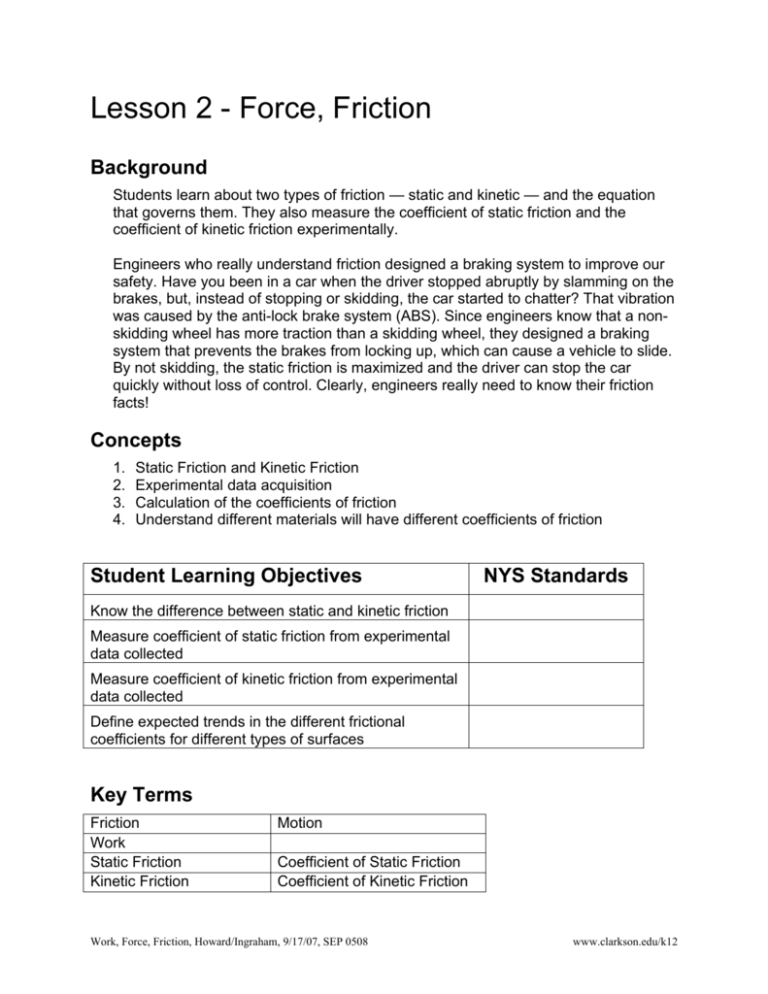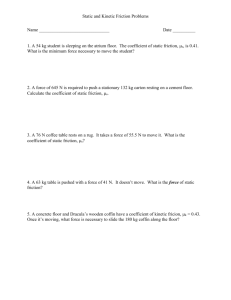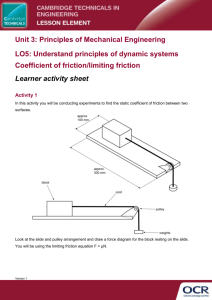Lesson 2 - Force, Friction
advertisement

Lesson 2 - Force, Friction Background Students learn about two types of friction — static and kinetic — and the equation that governs them. They also measure the coefficient of static friction and the coefficient of kinetic friction experimentally. Engineers who really understand friction designed a braking system to improve our safety. Have you been in a car when the driver stopped abruptly by slamming on the brakes, but, instead of stopping or skidding, the car started to chatter? That vibration was caused by the anti-lock brake system (ABS). Since engineers know that a nonskidding wheel has more traction than a skidding wheel, they designed a braking system that prevents the brakes from locking up, which can cause a vehicle to slide. By not skidding, the static friction is maximized and the driver can stop the car quickly without loss of control. Clearly, engineers really need to know their friction facts! Concepts 1. 2. 3. 4. Static Friction and Kinetic Friction Experimental data acquisition Calculation of the coefficients of friction Understand different materials will have different coefficients of friction Student Learning Objectives NYS Standards Know the difference between static and kinetic friction Measure coefficient of static friction from experimental data collected Measure coefficient of kinetic friction from experimental data collected Define expected trends in the different frictional coefficients for different types of surfaces Key Terms Friction Work Static Friction Kinetic Friction Motion Coefficient of Static Friction Coefficient of Kinetic Friction Work, Force, Friction, Howard/Ingraham, 9/17/07, SEP 0508 www.clarkson.edu/k12 Lesson Plan Begin the class by demonstrating some examples of friction (i.e. try to slide on floor with sneakers vs. leather-sole shoes, rub two objects together to create heat, etc.). We often want to maintain contact with a surface so utilize “good” friction to our advantage. But at same time, might not want materials heating up, so want to minimize “bad” friction. Ask the students to give additional examples of good and bad friction that might be applicable to roller coasters • • Good friction examples: person on seat of roller coaster – need some friction to stay put, braking system when want to stop Bad friction examples: in engines, causing parts to heat up and break, or in your in wheel bearings (like roller blades or skate boards), or between wheels and rails. Friction can waste energy, wear down parts and cause things to heat up. But we also depend on friction to keep our shoes/feet from sliding out from under us and to keep our cars on the road (from friction between road and our car's tires). Recall that work = force X distance. You need to work harder (e.g., expend more energy) to move an object a certain distance if there are frictional forces to overcome. Some notes about Friction: (depth in lecture can vary) • • • • • • • is essentially an electrostatic force between two surfaces never initiates motion; it only responds to motion depends on the types of materials that are in contact (µ - the coefficient of friction) depends on the net force normal pressing the two surfaces in contact (N) acts parallel to the surfaces that are (or might have the potential to be) moving with respect to each other opposes the direction of motion is independent of the area of the surfaces in contact Two types of friction: static friction and kinetic friction Static friction - resists an object to start moving or sliding Kinetic friction - resists an object that is already moving or sliding and always acts in a direction opposite of the motion (the reason that anything sliding freely will eventually come to a stop) Note: static friction is always stronger than kinetic friction Static and kinetic friction between an object and the ground can be calculated using the following equation: Work, Force, Friction, Howard/Ingraham, 9/17/07, SEP 0508 www.clarkson.edu/k12 FF = μ x N Where, FF is the frictional force, μ is the coefficient of friction, N is the Normal force μs - coefficient of static friction, used when an object is not sliding μk – coefficient of kinetic friction, used when object is sliding (see http://www.glenbrook.k12.il.us/gbssci/Phys/Class/newtlaws/u2l2b.html#friction ) Approximate values of some frictional coefficients Coefficient of kinetic friction Coefficient of static friction Rubber on dry concrete 0.68 0.90 Rubber on wet concrete 0.58 Rubber on dry asphalt 0.67 0.85 Rubber on wet asphalt 0.53 Rubber on ice 0.15 Waxed ski on snow 0.05 0.14 Wood on wood 0.30 0.42 Steel on steel 0.57 0.74 Copper on steel 0.36 0.53 Teflon on Teflon 0.04 Data from NYSED science regents examinations (http://www.nysedregents.org/testing/scire/arcphys.html ) Goal of class today is to observe and measure static and kinetic friction. The values for μ are usually found experimentally. In this activity, a method of calculating μs and μk from measured gravitational forces and application of free body diagrams. Demonstrate activity and distribute activity sheets. Explain that when the object begins to move – the static frictional force equals the gravitational force on the basket. Draw free body diagram. Group Question: During the activity, ask the groups: • • • • Why are we using fishing line instead of rope or string? (The fishing line is very thin and smooth, resulting in any friction between the table and the line being extremely small — so small that it can be ruled out. If we used rope or string, we might have to take into account its frictional effects.) How could we make the experiment even more accurate? Why is static friction stronger than kinetic? Which surface material will have greatest coefficient of friction? Why? Work, Force, Friction, Howard/Ingraham, 9/17/07, SEP 0508 www.clarkson.edu/k12 Supply list Each group needs: • • • • • • • • • 3 ft. fishing line Block of wood ~ 10 cm on each side with different materials glued on 3 of sides, small eye screw on 5th side (materials could include felt, sandpaper, plastic etc.) Extra block of wood (approximately same size) Weights (e.g., total weights required will be greater than the weight of the two blocks of wood) Small wicker or plastic basket with a handle Desk or table copies of the activity sheets Scale Tape Reflective Notes Factor in settle time, worksheet may need to be adapted for each classroom’s experience level, remind students to bring the worksheet for the next day to complete analysis and discuss as necessary. The measurement and analysis might take two days Depending on total class time, the teacher can assign different groups to complete experiment with one or two of the materials if there is not time to complete the experiment with all 4 materials. There are more precise ways to determine coefficients of kinetic friction, but they really require precise measurement of the block velocity and are limited to laboratories that have suitable data acquisition equipment. Taping ¾ of a PVC pipe over the corner of the table edge would reduce frictional losses on the string Table string Work, Force, Friction, Howard/Ingraham, 9/17/07, SEP 0508 www.clarkson.edu/k12 Activity –Force, Friction Background One safety element of roller coaster design is the braking system. Brakes are a good example of work, force, and friction working to our advantage. Engineers who really understand friction designed a braking system to improve our safety. Have you been in a car when the driver stopped abruptly by slamming on the brakes, but, instead of stopping or skidding, the car started to chatter? That vibration was caused by the anti-lock brake system (ABS). A non-skidding wheel has more traction than a skidding wheel; they designed a braking system that prevents the brakes from locking up, which can cause a vehicle to slide. By not skidding, the static friction is maximized and the driver can stop the car quickly without loss of control. Introduction/Motivation Friction can waste energy, wear down parts and cause things to heat up. But we also depend on friction to keep our shoes/feet from sliding out from under us and to keep our cars on the road (from friction between road and our car's tires). Two types of friction: static friction and kinetic friction Static friction - resists an object to start moving or sliding Kinetic friction - resists an object that is already moving or sliding and always acts in a direction opposite of the motion (the reason that anything sliding freely will eventually come to a stop) Note: static friction is always stronger than kinetic friction – more force is needed to start to move an object than to keep it sliding. Static and kinetic friction between an object and the ground can be calculated using the following equation: FF = μ x N (1) Where, FF is the frictional force, μ is the coefficient of friction, N is the normal force μs - coefficient of static friction, used when an object is not sliding μk – coefficient of kinetic friction, used when object is sliding The values for μ are usually found experimentally. In this activity, a method of measuring μs and μk will be introduced. Work, Force, Friction, Howard/Ingraham, 9/17/07, SEP 0508 www.clarkson.edu/k12 Materials: • • • • • • • • 3 ft. fishing line Block of wood (~10 cm each side) with eye screw and various materials glued on at least three sides of one block (examples - sandpaper, plastic, felt) Extra block of wood ~ same size Weights N = F g (N=normal force) Small wicker or plastic basket with a handle Table top Block Desk or table T Scale Ff Tape T Procedure Basket and added weight provide force to oppose frictional force Fg = mblock g Set up experiment 1. Record the mass of the blocks and the basket (T=Tension in string) Fg =mbasket g 2. Tie the fishing line to the eye screw 3. Tie the other end of the line to the basket handle and hang the basket off the edge of a table. Place the box in the center of a desk/table. Static friction experiment 4. Gently add weights to the basket (start with ~ the same mass as the block of wood). 5. Continue to gradually add weight until the block starts to slide. To increase accuracy, add small amounts of weight at a time. 6. Record the total amount of mass in the basket that finally caused the block to begin sliding. 7. Repeat steps 4-6 once with the same system. 8. Repeat steps 4-7 with extra block of wood on top of the original block 9. Turn the wooden block so a different surface material is in contact with the table and Repeat steps 4-8 for each material. 10. Calculate the average coefficient of static friction for each trial (see data sheet) Kinetic Friction Experiment – in this case, the measurements are made as the block is sliding. The general idea is to have less weight in the basket and to tap the block to initiate sliding at a constant velocity. You will be the judge of that! 11. Use the same set up as above. Chose just one of the materials to complete the experiment. 12. Start with approximately one-half of the mass in the basket that was required to initiate sliding in the static experiment. Work, Force, Friction, Howard/Ingraham, 9/17/07, SEP 0508 www.clarkson.edu/k12 13. Tap the block with your finger. The goal is to initiate the block moving across the table at a constant velocity (you are the judge!). If the block does move at a constant velocity, record the mass in the basket. If it does not, add some more weight to the basket and repeat until the constant velocity movement is achieved. 14. Repeat steps 11 – 12 with the same set up. 15. Repeat steps 11-14 with the extra block on top of the sliding block. 16. Calculate the coefficient of kinetic friction Work, Force, Friction, Howard/Ingraham, 9/17/07, SEP 0508 www.clarkson.edu/k12 Data and Discussion Questions –Force, Friction Name: _______________ Static Friction Data: Mass of block with eye screw: __________kg Mass of extra block: __________kg Mass of empty basket: __________kg Material 1 _________________ Mass in Basket (kg) Total Mass of Basket (kg) Total Mass of Block(s) (kg) Normal force of block(s) (N =m g) Grav. Force Basket (F =m g) μs (from eqn. 1) Average μs Material 2 _________________ Mass in Basket (kg) Total Mass of Basket (kg) Total Mass of Block(s) (kg) Normal force of block(s) (N =m g) Grav. Force Basket (F =m g) μs (from eqn. 1) Average μs Work, Force, Friction, Howard/Ingraham, 9/17/07, SEP 0508 www.clarkson.edu/k12 Material 3 _________________ Mass in Basket (kg) Total Mass of Basket (kg) Total Mass of Block(s) (kg) Normal force of block(s) (N =m g) Grav. Force Basket (F =m g) μs (from eqn. 1) Average μs Material 4 _________________ Mass in Basket (kg) Total Mass of Basket (kg) Total Mass of Block(s) (kg) Normal force of block(s) (N =m g) Grav. Force Basket (F =m g) μs (from eqn. 1) Average μs Discussion Question 1. How does μs vary with mass of the blocks? With the surface material? Are these results consistent with what you expected based on theory (equation 1) and your knowledge of friction? Explain. Work, Force, Friction, Howard/Ingraham, 9/17/07, SEP 0508 www.clarkson.edu/k12 Kinetic Friction Data: Record the mass in basket when you were able to get blocks to slide at a constant velocity after tapping with your finger. Material: ________________ Mass in basket required to initiate sliding: _________kg (from results of static friction experiment. You should need less mass for this experiment) Mass in Basket (kg) Total Mass of Basket (kg) Total Mass of Block(s) (kg) Normal force of block(s) (N =m g) Grav. Force Basket (F =m g) μk (from eqn. 1) Average μs Discussion questions: 2. How does μk for compare to μs for the same material? Is this the trend that you expected? Explain. 3. Why are anti-lock breaks in cars more effective on slick roads than regular breaks? (Anti-lock breaks are used in cars so that when someone slams on their breaks, the breaks lock for a split second and then release, then lock for a quick second again, and so on.) 4. As an engineer, how would you build a solid structure that is extremely difficult to move and easy to move at the same time. Use the information about friction you just learned. Can you apply these ideas to the design of a roller coaster? Work, Force, Friction, Howard/Ingraham, 9/17/07, SEP 0508 www.clarkson.edu/k12






